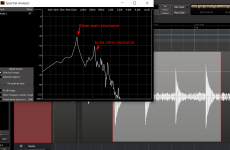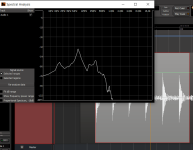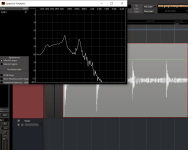What will you do when you find your recently successfully built DIY speakers have a lot of cabinet talk (cabinet resonance) in spite of the fact that you have already applied a lot of bracing?
Could it be compensated by tweaking the crossover network? Let’s say if you heard a cabinet talk, then you suddenly measured FR and found peaks at some region, e.g., 400 Hz. Can the problem be fixed by introducing a gap in that crossover region, e.g., about 300–500 Hz?
Or are there any more proper or correct methods of eliminating the cabinet resonance?
Could it be compensated by tweaking the crossover network? Let’s say if you heard a cabinet talk, then you suddenly measured FR and found peaks at some region, e.g., 400 Hz. Can the problem be fixed by introducing a gap in that crossover region, e.g., about 300–500 Hz?
Or are there any more proper or correct methods of eliminating the cabinet resonance?
Hi, if you want low noise box you must employ all tricks you know! 🙂 Keep panels small, volume small so any resonances are as high frequency as possible, above pass band. To push resonances up reduce panel weight, increase stiffness choosing right material and proper bracing, utilizing shape and tension. And it matters how you brace. Then you could dampen the panels somehow. You could also use dual opposing drivers to reduce vibration, attach driver from magnet, and so on.
Big box two way speaker with wide pass band, poor bracing and heavy low stiffness panels would be about worst you can do. Small box three way, stiff light panels and proper bracing and CLD damping for example, would be much less noisy in this regard.
Of course there is gray area between where performance is likely fine, and everything depends on how far you want to go. You could use EQ, but as the response likely varies per direction it's just a local relief. You could use steep low pass filter, especially if you have FIR capable DSP. You could make new box with better bracing scheme and so on.
My bass boxes are fourth iteration, and could be improved still! 🙂 Prepare do prototypes until you are happy with performance, only then make finished boxes. Or prepare to accept performance you happen to get.
Have fun! 🙂
Big box two way speaker with wide pass band, poor bracing and heavy low stiffness panels would be about worst you can do. Small box three way, stiff light panels and proper bracing and CLD damping for example, would be much less noisy in this regard.
Of course there is gray area between where performance is likely fine, and everything depends on how far you want to go. You could use EQ, but as the response likely varies per direction it's just a local relief. You could use steep low pass filter, especially if you have FIR capable DSP. You could make new box with better bracing scheme and so on.
My bass boxes are fourth iteration, and could be improved still! 🙂 Prepare do prototypes until you are happy with performance, only then make finished boxes. Or prepare to accept performance you happen to get.
Have fun! 🙂
Last edited:
I don't think this would work well... applying a big dip in this frequency range is going to be very audible.Could it be compensated by tweaking the crossover network? Let’s say if you heard a cabinet talk, then you suddenly measured FR and found peaks at some region, e.g., 400 Hz. Can the problem be fixed by introducing a gap in that crossover region, e.g., about 300–500 Hz?
If you can identify the area of the cabinet that is radiating, it gives you a place to start... play pink noise or sine sweeps. Use a mechanics stethoscope to listen to the cabinet and find the area of loudest radiation. You can find these in an autoparts store, or borrow one from an automobile mechanic...
Intuitively, which would one think would be effected the most; the direct sound from the drivers, or the "excited cabinet" sound? Say, if you notched out a note corresponding to some panel resonance...
Not sure... but if the resonance is very audible, it will probably be a low-Q resonance, which means the notch will need to be a low Q notch... Imagine a -4 dB PEQ at 350 Hz, Q=8... maybe not audible, but it may not get the job done... now imagine if the Q was reduced to 2. Ouch!
Is using RTA microphone with REW software insufficient?I don't think this would work well... applying a big dip in this frequency range is going to be very audible.
If you can identify the area of the cabinet that is radiating, it gives you a place to start... play pink noise or sine sweeps. Use a mechanics stethoscope to listen to the cabinet and find the area of loudest radiation. You can find these in an autoparts store, or borrow one from an automobile mechanic...
View attachment 1212208
I had tried active bi-amplification configuration. I set the crossover points at 300 and 500 Hz for LP of woofer and HP of midrange, respectively, my speakers are three-way, with 24 dB/octave Linkwitz-Riley slopes. The result was not better and was probably likely to be worse. So, is there any advice on using active crossover to solve problems?
perhaps. I have not tried that. I have done near field scans of cabinet walls to detect if there was a problem. But in your case, you already know you have a problem. The next step is to figure out which spot on the cabinet is vibrating, and then add some effective bracing or damping to that spot. You could try slow sine sweeps and use your hand to feel the vibration. It might work...Is using RTA microphone with REW software insufficient?
You can get some data by using the driver as mic, hookup the speaker cable to and XLR plug to hook it up to a mic preamp on your audio interface. Tap the box with your knuckle and record to a Digital Audio Worksstation, then analyze the recorded audio to see the resonances. Do it for all the panels on your box, do multiple times as consistency matters and so on.
Example:
Box back panel knocked, box without any damping, and then with:


Here one side knocked:

While this isn't the most elegant way of doing it, it's one easy method to evaluate your box. There is quite lot of variables involved knocking around free hand; Some knocks show very different spectra, and for example knocking side of the box shows same peak about ~300Hz as knocking the back panel, even though panel size and bracing scheme is different. Change from adding damping to the box seems to be noticeable though.
The most significant resonance that transmits to the driver somehow, either as acoustic pressure from inside the box or through the structure and driver mounting, is about 300Hz on all these. It could be fundamental sound of my knock as well, the speaker is quite sensitive as microphone. Anyway, seeing it there I could try and EQ 300Hz some if wish, and of course try stiffen the box, or use another method to excite the box. Anyway, one nice tool to know.
Example:
Box back panel knocked, box without any damping, and then with:


Here one side knocked:

While this isn't the most elegant way of doing it, it's one easy method to evaluate your box. There is quite lot of variables involved knocking around free hand; Some knocks show very different spectra, and for example knocking side of the box shows same peak about ~300Hz as knocking the back panel, even though panel size and bracing scheme is different. Change from adding damping to the box seems to be noticeable though.
The most significant resonance that transmits to the driver somehow, either as acoustic pressure from inside the box or through the structure and driver mounting, is about 300Hz on all these. It could be fundamental sound of my knock as well, the speaker is quite sensitive as microphone. Anyway, seeing it there I could try and EQ 300Hz some if wish, and of course try stiffen the box, or use another method to excite the box. Anyway, one nice tool to know.
Is using RTA microphone with REW software insufficient?
The mechanics stethescope will let you quickly, qhile playing music, determine exactly where any (potential) resonance is set off so that you know th espot you have to fix.
If a microphone detects a resonance it is a little tiny blip in a bunch of blips. If it is detected it doesn’t really tell you where it is.
Now REW with an accelerometer might work and will give qualitative results. But really a whole lot slower.
Worthwhile if you are Stereophile publishing a test, but you just want to make your speaker not ring.
And no, you cannot fix it with an XO.
dave
And if there is no stethescope at hand, with some luck you might be able to hear it by ear, just put your ear quite close to the box and try to find it. I'd try with some multitone signal playing.
Is there mods (resonances) inside a cabinet that increases some frequencies through the cones more than through the walls ? Which is singing most ?
Said in other words : what are worse : outside housing singing or bad internal dimension that play to much on the internal driver cone, so through its external cone creating peaks ? What is worse : THD of stiff Qe and Qm or too lossy Qe and Qm according what is happenning inside the cabinet... hence the good resullts of progressive air compliance of the sealed designs there ?
Anyway, but bracing and stuffing some are using golden ratio dimensions to the box internal shape to cancel some modes but dunno if myth or if that works!
Said in other words : what are worse : outside housing singing or bad internal dimension that play to much on the internal driver cone, so through its external cone creating peaks ? What is worse : THD of stiff Qe and Qm or too lossy Qe and Qm according what is happenning inside the cabinet... hence the good resullts of progressive air compliance of the sealed designs there ?
Anyway, but bracing and stuffing some are using golden ratio dimensions to the box internal shape to cancel some modes but dunno if myth or if that works!
Worse is meant to be a greater mid-low frequency, a richer male voice, or an excessive "Umm" sound.
I am more worried about narrow spikes with excessive spl that are hard to tame w/o DSP or too much passive parts. Nulls are non offensive if width is limited.
Passive filters designs are harder to get rigth for average enthusiasts like I am VS DSP. While FIR before the dac is always possible.
Passive filters designs are harder to get rigth for average enthusiasts like I am VS DSP. While FIR before the dac is always possible.
hear it by ear, just put your ear quite close to the box
You can use a glass to amplify what you hear.
dave
It may sound like some kind of bad joke but eliminating the cabinet will 100% eliminate these panel an internal standing wave resonances.What will you do when you find your recently successfully built DIY speakers have a lot of cabinet talk (cabinet resonance) in spite of the fact that you have already applied a lot of bracing?
Could it be compensated by tweaking the crossover network? Let’s say if you heard a cabinet talk, then you suddenly measured FR and found peaks at some region, e.g., 400 Hz. Can the problem be fixed by introducing a gap in that crossover region, e.g., about 300–500 Hz?
Or are there any more proper or correct methods of eliminating the cabinet resonance?
This is why I have been building nude dipole loudspeakers.
Sometimes when I go to DIY speaker competitions or demo sessions I can "hear" the box quite clearly now that I know what "no box" sounds like or doesn't sound like I guess!
I would like to have two sota measurement in the same room (for illustration baffle less vs Sealed) to understand if it is about the cabinet or just the shape of the spl magnitude in the room ?! : Less bass (baffle less) = more easy sound and energy where it is pleasing (80 to 200 hz) in the bass ?
Last edited:
The problem is solved! I rechecked the polarity of each driver and found one of HP had the wrong polarity. I reconnected it, and the problem was gone.
If that fixed the issue, it was not a box resonance.
dave
- Home
- Loudspeakers
- Multi-Way
- Speakers have a lot of cabinet resonance